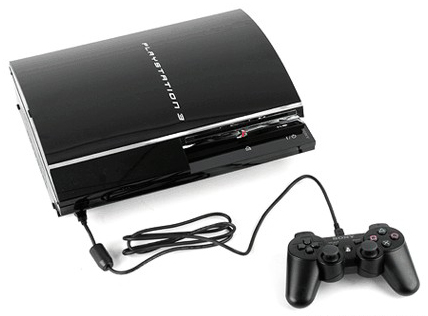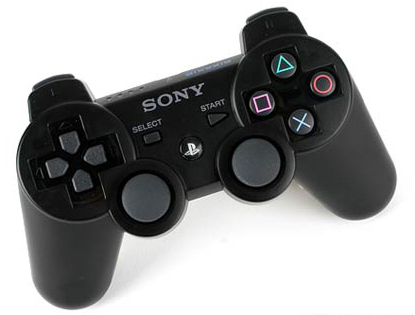
The wireless controller recharges by connecting via the included USB cable.
As for the controller's design, Sony has made a few tweaks. The L2 and R2 trigger buttons are a bit bigger, and the increased depth in stroke offers players more subtle game control. Sony has also increased the tilting angle of the analog joysticks to give you more precise control and a wider range of motion. Those analog sticks are more sensitive as well. The PS2's Dual Shock controller had 8-bit sensitivity, while the PS3's controller has 10-bit motion detection. The big omission is force feedback support: the PS3 controller offers no vibration or rumble control, which is a bit of a bummer.
However, you do get something called SixAxis motion sensing, which means the controller's capable of sensing motion in six directions: up, down, left, right, forward, and backward. Game developers have incorporated it many of the new games in one form or another. For example, in 2K Sports' NHL 2K7, a quick thrust of the controller makes your defensive player perform a check. In Tony Hawk's Project 8, you can steer your skater and control his movements by tilting the controller from side to side and forward and back. Sony's NBA '07 also makes interesting use of the tilt feature, allowing you to control a player's moves and jukes on offense.
To be sure, some implementations of the tilt sensitivity are better than others. Furthermore, it's unclear if all the games that utilize motion sensitivity will require it - some are optional and can be switched off, and we could certainly see some folks not wanting to bother with them at all. Clearly, Sony wanted to steal some of Nintendo's thunder, and there's no denying that the Wii's motion-sensitive controllers are more central to that console's DNA. The Wii controllers are also more sophisticated, including the ability to measure actual motion (spatial movement) and acceleration, rather than just tilting - but unlike the Wii, the PS3 doesn't require a motion-sensor bar in front of the TV. (The current Xbox 360 controllers offer no motion sensitivity at all.) It's safe to say we'll see more innovative uses of the tilting sensitivity feature in future games - it definitely added an extra level of control when flying the eponymous attack vehicle in Warhawk (we played an early build at E3 2006, but the game isn't due until sometime in 2007).

The SixAxis controller: if it ain't broke, don't fix it.
Unlike the PS2 controller, the SixAxis controller has a centered Home button, which functions much like its counterpart on the Xbox 360 controller. You use it to return to the console's main menu screen, as well as to sync the controller to the console and start it up or shut it down wirelessly.
Design of Sony PlayStation 3
Sony PlayStation 3's Interface
<< Back to Sony PlayStation 3 Review

No comments:
Post a Comment